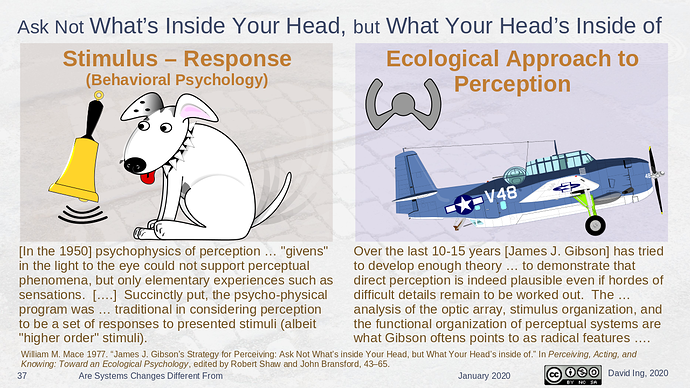For me, there’s a lot to be learned by observing the evolution of the state-of-the-art in systems research.
In the first of four lectures at OCADU in winter 2020, I presented a slide summarizing a distinction between behavioral psychology and ecological psychology.
Back in 1934, we had the article by S. C. Pepper, followed by the Tolman & Brunswick in 1935.
In 1950, J.J. Gibson would publish The Perception of the Visual World, and would become recognized by his peers in psychology. It wasn’t until 1979 that The Ecological Approach to Visual Perception would provide more philosophical foundations leading to the idea of affordances.
In 1956, we had the launch of “Behavioral Science, A New Journal”, with James Grier Miller, as one of the leaders in General Systems Theory (that would become known as the Systems Sciences). This journal would merge in 1996 with a parallel journal to become known as Systems Research and Behavioral Science.
In 1965, Emery & Trist would publish “The Causal Texture of Organizational Environments", that would introduce the socio-ecological systems perspective (that should be framed with the socio-psychological and socio-technical).
In 2000, Tim Ingold published The Perception of the Environment: Essays on Livelihood, Dwelling and Skill, that pieced together J.J. Gibson with the work of Gregory Bateson (who originated, but actually didn’t publish ecological epistemology).
So, while novices are still trying to make sense of “Ask not what’s inside your head, but what your head’s inside”, there’s been a more recent advance that has helped my understanding.
In 2017, Tim Ingold published “On Human Correspondence”, that brought the idea of being alongside – not just what’s inside your head, or what your head’s inside – that helped me with Open Innovation Learning (Ing, 2017).
I didn’t read all of this research in the sequence that they were released. For someone new to the variety of ideas in the systems sciences (i.e. the ISSS), there’s a lot to sort out.
References
Alexander, Franz, Alex Bavelas, Ralph W. Gerard, Donald G. Marquis, Jacob Marschak, James G. Miller, Anatol Rapoport, Ralph W. Tyler, and Raymond Waggoner. 1956. “Editorial: Behavioral Science, A New Journal.” Behavioral Science 1 (1): 1–5. https://doi.org/10.1002/bs.3830010102.
Emery, Fred E., and Eric L. Trist. 1965. “The Causal Texture of Organizational Environments.” Human Relations 18 (1): 21–32. https://doi.org/10.1177/001872676501800103. Anthology (1997) preprint at www.moderntimesworkplace.com/archives/ericsess/sessvol3/sessvol3.html .
Gibson, James Jerome. 1979. “The Theory of Affordances.” In The Ecological Approach to Visual Perception , 127–43. Boston: Houghton Mifflin.
Ing, David. 2017. Open Innovation Learning: Theory Building on Open Sourcing While Private Sourcing . Toronto, Canada: Coevolving Innovations Inc. https://doi.org/10.20850/9781775167211.
Ingold, Tim. 2000. “General Introduction.” In The Perception of the Environment: Essays on Livelihood, Dwelling and Skill , 1–7. Routledge. http://doi.org/10.4324/9780203466025.
Ingold, Tim. 2017. “On Human Correspondence.” Journal of the Royal Anthropological Institute 23 (1): 9–27. https://doi.org/10.1111/1467-9655.12541.
Pepper, S.C. 1934. “The Conceptual Framework of Tolman’s Purposive Behaviorism.” Psychological Review 41 (2): 108–33. https://doi.org/10.1037/h0075220.
Tolman, Edward C., and Egon Brunswik. 1935. “The Organism and the Causal Texture of the Environment.” Psychological Review 42 (1): 43. https://doi.org/10.1037/h0062156.

